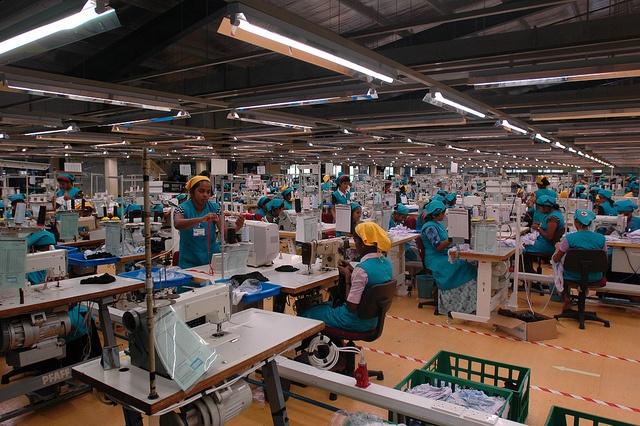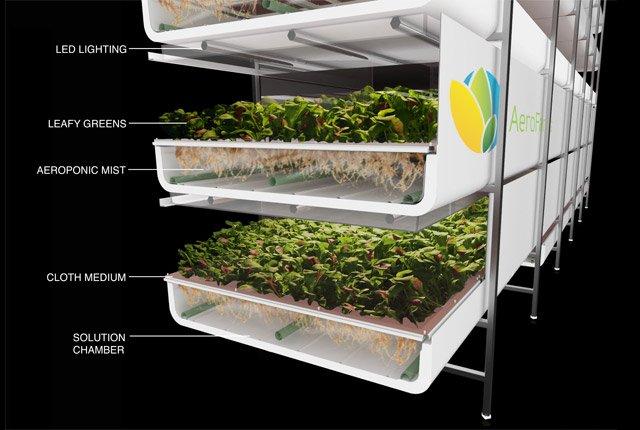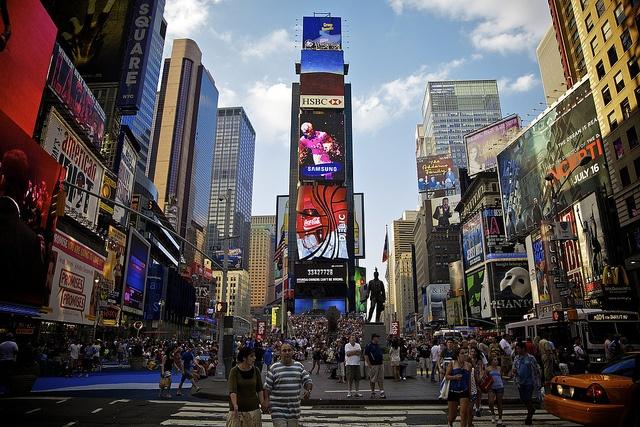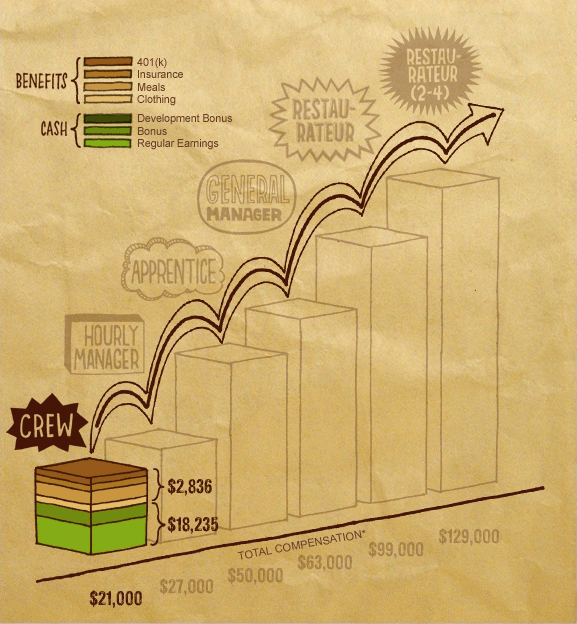Myanmar Officials Proposed a Minimum Wage and Factories are Already Fighting It


Garment factories in Myanmar, the Asian country formerly and perhaps better known as Burma, aren’t happy with the government’s proposal to institute the country’s first minimum wage — a measly $3.25 per day, equating to just 40 cents an hour. The big-time clothing companies these factories supply, like Gap and H&M, have yet to publicize where they stand on the suggested rate.
While $3.25 doesn’t sound like much of a victory for the Myanmar government, it’s still a 225 percent increase from the current starting pay nearing $1 a day. The Myanmar Garment Manufacturers Association isn’t pleased with the proposal, suggesting $2 a day would serve best for the workers and the companies struggling to stay in business.
For U.S. companies, Myanmar is an open door to cheap, yet reliable, clothes. When the country overcame decades of military dictatorship in 2011, President Barack Obama lifted sanctions restricting U.S. involvement in the country, thus allowing free trade for any American company to any Myanmar factory. Gap was the first to jump the bandwagon, publicly signing the deal on the circumvented idea that the increased workload “will play a key role in helping to fuel the economic prosperity of the country.”
The underlying problem remains that the workers, through buckets of sweat and countless injuries, remain empty-handed. Garment factory bosses have seemingly taken on the disputed “trickle-down approach” by denying reasonable wages. Job scarcity in the once war-torn country leaves the factory workers with little choice but to show up day-in and day-out.
Gap and H&M have maintained good public relations since relying on the Eastern world to develop their clothes -- openly committing themselves to improve working conditions, particularly forced labor and unfair overtime demands. Yet these companies that supposedly champion labor reform are suddenly unwilling to voice their opinions on the newly proposed minimum wage.
Business and Human Rights Resource Center researcher Irene Pietropaoli said Gap and H&M could easily influence the wage debate if need be. Burmese authorities are deeply committed to enticing foreign investment, so they’d almost undoubtedly oblige the opinion of such large-scale companies. Companies have next to no legal obligations to improve labor conditions, but profitable businesses would be smart to avoid standing up for unlivable wages.
As of now, it’s hard to compete with Myanmar’s affordability. Companies are increasingly licking their lips when looking at Myanmar as a prospective factory location. Stacked next to Eastern rivals, Myanmar is far and beyond the most appealing, cost-effective place to set up shop. Even with the proposed wage of $3.25 a day, or $65 a month, Myanmar would remain a heavy player in the garment-making industry.
Poor working conditions in Southeast Asia were spotlighted in 2013, when the Rana Plaza factory collapse killed more than 1,000 garment workers in Bangladesh. Although the area received national media attention, wages and way of life for workers in the region remained unsettled, even with powerhouse companies like Target and Walmart signing contracts with factories there.
Of the 172 countries documented by risk-analytics firm Verisk Maplecroft, only one had lower labor costs than Myanmar: Djibouti, on the Horn of Africa, a nation of around 900,000 people compared to Myanmar's 53.3 million. Outsourcing to Myanmar instead of neighboring Thailand saves Western manufacturers around $18 per worker per day because of the high — in relative terms, of course— wages Thailand workers receive.
Along with generally cheap labor per individual worker in Burma, health regulations haven’t been updated in the region since 1951. The country is still new, only existing without British control and military dictatorship for four years, so the standards are likely to increase year-in and year-out. But in the meantime, Myanmar seems to be the best place to outsource on a strict, surplus basis.
Myanmar officials are faced with the challenge of creating working standards for the country or minimizing costs to attract foreign businesses. Gap and H&M’s silence on the issue can’t last forever, and ultimately the companies’ reaction to the wage spike will speak louder than any press release statement. Only time will tell.
Image credit: Flickr/ILO in Asia and the Pacific
Vertical Farm Takes Food Production to New Heights


If you happened to overhear someone talking about the relative fertility of cities, you’d probably think they were talking about the birth rate, rather than how much food they can grow. But that perception might be about to change. It’s time to turn the page on what we once thought was necessary for farming, which is, among other things, open spaces and fertile fields.
While you were busy looking the other way, a new way of farming has, well, sprouted up -- as in, you might have to look up to see it.
In the city of Newark, New Jersey, a company known as Aero Farms has decided to build a new $30 million corporate headquarters in an abandoned steel mill, which will include a vertical farm. Goldman Sachs and Prudential Financial are partners in the project. When complete, the 69,000-square-foot facility will grow roughly 2 million pounds of baby greens and herbs, creating 78 new jobs in an area with an unemployment rate that is twice the national average. Aero Farms claims that its sustainable farming model, which uses no pesticides, grows 75 times more food per square foot and consumes 95 percent less water than traditional methods.
This facility will be the world’s largest indoor vertical farm. The crops will be grown in what are called “growing rooms,” which look like giant warehouse racks. The soil-free farm will utilize so-called “aeroponic farming,” where seeds are sprouted atop a cloth medium, fed by misters below and illuminated by proprietary LED lighting from above.
Aero Farms was established in 2004, in upstate New York. Its innovative, patented growing technology was developed by former Cornell Cooperative Extension director, Ed Harwood (now chief science officer). The company’s mission is to “build and operate responsible farms throughout the world enabling local production at scale to grow safe, nutritious and delicious food.”
The principals have won numerous awards including:
- 2010 and 2008 Technology Pioneer, World Economic Forum
- 2008 Time Magazine – Top 4 Enterprise for Leading Edge of the New Energy Frontier
- 2010 Finalist for Ernst & Young Entrepreneur of the Year Award for NJ
- 2009 Best New Jersey CleanTech Company of the Year awarded by NJ Tech Council
With this classic case of disruptive innovation, the company eliminated the need for all of the classic requirements for farming: land, sun and water, and substituted completely controllable elements in their place. This opens the possibility of food being grown in places where it could never have been grown before. It will certainly be interesting to see if this model can succeed and if it can be replicated at other locations around the world.
Image courtesy of Aero Farms
Renewables -- 70% of New Power This Year


The future of electricity in the U.S. of A is in renewables. Renewable energy accounted for almost 70 percent (69.5 percent) of new electricity generation in the U.S. during the first half of this year.
The recent report by the Federal Energy Regulatory Commission’s (FERC) Office of Energy Projects found that wind accounted for almost 2,000 megawatts of new generating capacity. That is over half of all new capacity. Solar accounted for 549 MW, biomass 128 MW, geothermal steam 45 MW, and hydropower 21 MW.
Natural gas accounted for 1,173 MW of new generating capacity, and nuclear power did not account for any new capacity. Coal only accounted for 3 MW of new capacity. That means that the new capacity from renewable energy sources is 904 times greater than coal and more than double natural gas, as Ken Bossong from the Sun Day Campaign pointed out.
In June, wind accounted for 320 MW, biomass 95 MW and solar 62 MW, which means that renewables made up 97 percent of new capacity last month. Natural gas only accounted for 15 MW.
In the U.S. renewables now account for 17.27 percent of total installed operating generating capacity, and are greater than nuclear power and oil, Bossong wrote. For comparison, renewables accounted for 13 percent of U.S. electricity generation last year, according to the U.S. Energy Information Administration.
There is a huge potential for renewable energy in the U.S. A study by the Department of Energy’s National Renewable Energy Laboratory (NREL) found that renewable energy sources could provide 80 percent of U.S. electricity generation by 2050.
How does your state rank in renewable energy generation?
The site Energy.gov ranks the states by renewable capacity. A handful of states rank very high, with renewables accounting for 80 to 100 percent of electricity generation: Washington, Oregon, Idaho, Nevada, South Dakota, Iowa, Delaware, Rhode Island and Maine.
Delaware, Rhode Island and Maine get most of their electricity generation from renewables. In Delaware, biomass accounts for the majority of electricity generation. In Maine, it’s hydropower and biomass, while Rhode Island is building the nation’s first offshore wind facility. The 6 MW wind farm is expected to come online in 2016.
Image credit: Flickr/Peter Heilmann
How Corporations Are Helping Curb the Global Water Footprint


By Anum Yoon
If someone grew up in a first-world country, they're used to having water at their fingertips. Clean water is so easy to come by that we never worry about it. However, water isn't ever-flowing, and droughts are reaching more and more people, even within the U.S.
Even in this data-driven age, the general public often doesn't keep up with the news. If you poll random people on the street, will they know about the droughts in California? Does the average New Yorker even know about wildfire season in the Southwest region of the United States?
The lack of awareness – let alone knowledge – of the global water shortage is dangerous. Can anyone wake up American consumers to this growing problem? You bet, and corporations are at the heart of curbing the global water footprint.
Is your business one of them?
Open the corporate toolbox
A corporate toolbox contains more than a lawyer and a strong IT team. It also contains responsibility – to consumers to create trusted products and to the environment through sustainability. There are many reasons why a company should care about a water footprint.
To start with, a corporate water footprint is used to track how much fresh water by volume is used to create a product or service. If a single company uses too much water, it risks pollution, dry rivers and lakes, and even hurting the wildlife population. From a business perspective, it also means fines, community complaints and even possible relocation, if not shuttering, of the business.
A key way to impact conservation is through the three Rs: reduce, reuse and recycle, which is exactly what Adidas did. Adidas and Parley recently teamed up to make clothing and sneakers from recycled ocean waste. This symbiotic relationship provided both companies with solid PR, plus it benefits the entire world, which makes this a strong example of how corporations can reduce their global water footprint.
Plus, when companies champion causes, the public takes an interest.
Increase public awareness
While U.S. citizens rank among the lowest of people concerned over water shortages, that number is changing due to California's worsening droughts and fire seasons. What do you want your company associated with – a saving-the-world superhero or just another logo attached to one more website on the Internet? Which one do you think would get more notice?
Using your corporate social responsibility as a marketing tool benefits you, the cause and the general public. Don't look at this as one more environmental issue, but rather an issue that affects how your business functions. Donating lump-sums to the cause won't impress your consumers for very long. Instead, look to companies like Adidas that engages in long-term projects that keep it in the spotlight. It’s making the company a part of a global sustainability initiative, which in turn makes it a superstar to the public.
Be a proactive corporation
Are you ready to join the ranks of corporate water stewards? Start by getting a water footprint assessment, which includes an assessment of your company’s production as well as a geographic assessment. The advantage lies in your company's ability to strategize a proper response and target decreasing the water footprint.
Other companies that have taken this step include Coca-Cola and other food and beverage giants.
Still trying to decide if a water footprint assessment is right for your company? Just stop and remember how quickly public opinion shifts. The U.S. might be behind the rest of the world when it comes to water and sustainability, but as the Southwest drought worsens and more people are affected, it's safe to say that more people will be looking for industry leaders to take action. Those leading companies will be the ones that stay ahead in their industry.
Image credit: Pete R.
Anum Yoon is a writer who is passionate about personal finance and sustainability. She often looks for ways she can incorporate money management with environmental awareness. You can read her updates on Current on Currency.
Practical Ways To Incorporate A Holistic Wellness Program into Your Organization


By Darryl Lewis
Over 66 percent of all U.S. employers have begun to offer wellness programs to their employees. These programs address many aspects of wellness, including emotional, spiritual and physical health. However, you don’t have to be a huge corporation to implement a holistic wellness program. As a small business owner, you can easily establish your own holistic wellness program without destroying your budget with these ideas.
1. The quiet room
Let’s face it: The office is a very busy place, and sometimes busy can be synonymous with noisy. The constant sounds of phones ringing, fax machines beeping and printers printing can be a bit overwhelming to some employees. Choose a room in your office to be the “quiet room." This should be a small room that employees can reserve for working on extra difficult projects, or even just to take a couple of minutes for themselves to breathe and release some stress.
Many U.S. offices are also beginning to allow employees to use quiet rooms as a “prayer room.” A majority of U.S. employees identify as being religious and participate in various forms of prayer and meditation. Enabling your employees to practice these activities will help them feel spiritually and mentally rejuvenated -- increasing their overall productivity.
2. Bring your (inner) child to work day
Sure, businesses should be professional, but that doesn’t have to translate into being uptight all the time. Allow your employees to bring their inner child to work. Taken literally, this means let your employees play! You can even incorporate this into a team-building exercise by having employees challenge and motivate each other in fun and unique ways.
For example, one fun and unique way to let your employees play at work is to hold Lego building competitions. This encourages teamwork, creativity, problem-solving and even bonding in the workplace. You might want to designate a specific room or area for Lego building though, as it can easily become a bit messy and take up quite a bit of space.
3. Hydration oasis
Hydration is a very important part of your employee’s health that often goes overlooked. Being properly hydrated can help increase focus and balance, control appetite, and even improve your employees’ moods.
However, you don't have to promote healthier hydration habits by drinking water alone. In addition to the water cooler, stock your organization's fridge with fresh fruits, vegetables and yogurts. These foods contain high water percentages to keep your employees hydrated throughout the day. To save money, buy locally at a farmer's market or produce stand. Take your hydration oasis to the next level by getting a blender or juicer from a flea market or thrift shop.
4. Bike rental program
To encourage your employees to bike to work more often, offer a bike rental program as part of your employee benefit package. Some busy cities such as Philadelphia, New York City and Los Angeles already offer bike rental programs to citizens, and they may be more than happy to extend a discount to your organization, especially if you can get enough employees to become involved.
There is also Zagster, an organization that works to design, build and operate bike-sharing programs for businesses across the country. If your business is on a very tight budget or is a startup with only a few employees, buy some bikes from the thrift store or flea markets.
5. Volunteerism
Serving others and the environment is a major component of holistic wellness. Set aside some time for you and your employees to devote to a positive cause. This can be as simple as participating in a local food drive or creating greeting cards for elderly residents at a nearby nursing home. Help improve your company’s sustainability efforts by planting a tree or starting a garden right outside of your office. Implementing a volunteer program is a great start to boosting your company's morale. Employees will feel more like a team, knowing that they're working together for an outcome greater than a paycheck or product.
Creating a holistic wellness program for your business doesn’t have to be stressful or expensive. When you choose any of these ideas, you’ll be able to improve the overall wellbeing of your employees while enhancing the company’s work culture.
Image credit: Pixabay/geralt
Darryl Lewis is a digital marketing and a fine/performing arts enthusiast. His concern about social and environmental issues is unwavering, always seeking opportunities to create a positive impact on the people in his community and the world. He holds a Bachelor of Science degree in Business Marketing from Stockton University. Follow him on Twitter @dlew4life
40 tonnes of rubbish cleared from beaches as plastic bag use rises


More than 40 tonnes of rubbish were removed from beaches by Marine Conservation Society (MCS) volunteers and Marks and Spencer (M&S) staff and customers during the Big Beach Clean-up in May. This covered 145km of beach and 3km of waterways, the greatest total distance covered by the clean-up since it began in 2012.
The Big Beach Clean-up was organised as part of the Forever Fish partnership which has seen MCS join forces with high street retailer M&S and the Canal & River Trust to help reduce plastic bag use and increase people’s understanding of the need to eat sustainable fish.
MCS Beachwatch Officer, Charlotte Coombes, said the items most commonly found were pieces of plastic, which topped the list of ten most frequently found items: “Plastic pieces, crisp and sweet wrappers, glass pieces, plastic bottles, anglers fishing line, plastic bags, paper, metal, wood and polystyrene. If MCS and its volunteers didn’t clean and survey our beaches, we would not be able to continue to pressurize the authorities into keeping marine and beach litter on the agenda. Our surveys reveal where the rubbish on our beaches come from. If we can stop the litter at source we can make beaches in the UK cleaner and safer places for wildlife and people.”
-
New figures from the Department for Environment, Food and Rural Affairs, show that the number of single-use plastic bags handed out by UK supermarkets has increased for the fifth year, rising to 8.5bn.From October large shops in England will have to charge for plastic bags. All retailers with 250 or more full-time equivalent employees will have to charge a minimum of 5p for the bags they provide for shopping in stores and for deliveries. A reduction in the number of plastic bags handed out by retailers was found in Scotland and Northern Ireland, where levies have been introduced.
American Humane Association: The Challenges of Policing Animal Abuse


Humane treatment of animals is a passionate topic in the U.S. -- or so we're told by the country's leading animal rights organizations. Defenders of Wildlife, Mercy for Animals, World Wildlife Fund and the Humane Society are just a few of the organizations that have gained prominence and voice in recent years, propelled by the increasing concern over the fate of animals, both in the wild and in captivity.
In the food sector, that concern is best captured in a 2014 American Humane Association survey, which stated that advocacy is rising: 95 percent of consumers surveyed stated they were very concerned about the humane treatment of animals, and 76 percent of respondents said they would allocate more of their food budget for meat that came from humanely raised animals. The survey was taken to show that the AHA's work, which includes certifying companies that treat farm animals humanely, had value and substance.
The significance of that tally came back to bite the AHA last month, however, when another animal rights organization released footage of employees at an AHA-certified processing plant abusing farm animals. 'Abusing' is perhaps far too gentle a term to use to describe the footage, but would presumably be sufficient for an organization that sees its mandate as "protecting children, pets and farm animals from abuse and neglect." But according to Mercy for Animals, the organization that revealed the abuse, neither Foster Farms, the owner of the plant, nor the American Humane Association came forward to say they would launch an investigation until the film clip actually went public. No statement has been issued on the AHA website addressing the incident.
Most of the attention concerning this scandal has been focused on Foster Farms, which has been under considerable consumer scrutiny for its earlier problems with antibiotic-resistant salmonella. When it comes to consumer confidence, accusations of animal abuse, especially to the degree detailed in the complaint, is an ill-timed follow-up to food sanitation problems.
The AHA might have missed most of the media attention if it hadn't been for venerable animal rights supporter Bob Barker, who is better known for his leading role in the television game show "The Price Is Right." At 91, he is still dolling out checks to animal rights organizations to the tune of millions of dollars. In Hollywood, Barker's scathing condemnation of the AHA found a willing audience and a well-appointed podium.
"I think they have failed miserably in their efforts to protect animals in the movie industry, and obviously they have failed miserably in any protection for animals in this food industry," Barker said in a press conference at the prestigious Millennium Biltmore Hotel in Los Angeles.
For many animal welfare supporters in show business, Barker's statement underscores a key gripe that animals are not always as protected as the disclaimer in movie credits state. In 2013, the Hollywood Reporter released a feature investigation into a string of animal deaths and injuries that had occurred under the AHA's watch. The AHA has denied many of the incidents, and it has also denied the wrongful termination of its Studio City-based production director Barbara Casey after two horses died. But for some, the concern that animals are not as protected from injury or pain on the set as the tagline says, still remains a stigma. Last year, a new organization, Movie Animals Protected, opened its doors on AHA Hollywood turf, led by its former production director, Barbara Casey, who maintains the AHA had been warned about problems of abuse.
For poultry producers, Hollywood may be a long way from Fresno, California's packaging plants, but it's likely not far enough for Northwest consumers who want to know that the meat they eat comes from humanely treated animals. Being the biggest organic poultry producer in a region may not count much for Foster Farms if its customer base loses the willingness to buy its chicken. And as many of America's most successful early companies learned, the wealth of a client's investment in an organization is meaningless if consumers don't invest the same faith in the certified product.
Image of chickens: Loozrboy
Image of AHA truck: Trailersoftheeastcoast
New York City's Government Buildings To Be 100 Percent Renewable


New York City Mayor Bill de Blasio took the first strides toward his goal to power all city government buildings and facilities with renewable energy within 10 years, asking the energy industry to help identify new sources of clean energy appropriate for the city. The call is likely to be followed by an official request for proposals this fall and potentially a signed contract in 2016.
While powering the city government may not sound like a tall task, the city operates more than 4,000 buildings and facilities. The plan will also cover all of NYC’s traffic lights and street lights. The city government coughs up a large chunk of change to keep these facilities running — between $600 million and $650 million annually. The 4 to 5 terawatt-hours of electricity spent each year on the buildings contribute around 3.2 million metric tons of carbon dioxide equivalent, good for nearly 7.5 percent of the largest American city’s greenhouse gas emissions.
De Blasio’s plan could expand to include public housing projects too, which would affect more than 400,000 New Yorkers, Grist reports. This isn’t the first time de Blasio is taking a progressive stance for renewables. Back in September, he pledged to reduce the city’s greenhouse gas emissions 80 percent below 2005 levels by 2050. He also eyed cutting emissions from city government operations 35 percent by 2025, meaning the government buildings would have to rely more heavily on solar and wind power than the current coal power.
De Blasio, who assumed office on New Year’s of 2014, has largely followed the path that his predecessor Michael Bloomberg paved for him. Bloomberg has donated millions of dollars to sustain the rapid growth of clean energy. Along with being philanthropic to ensure purity of American energy, Bloomberg has also been a champion ambassador, representing and fighting for clean energy worldwide.
De Blasio’s resume for renewable energy may not be as shiny as Bloomberg’s, but the current mayor’s ambitious goal for renewable-powered government buildings could influence other major American cities to follow in the Big Apple’s footsteps.
New York City’s metropolitan area — including suburbs in four different states — is by far the most populous in the country with more than 23 million people. Amazingly, New York joins Idaho and Arkansas as the three states with the smallest ecological footprint. Improving renewable energy in the city that never sleeps could only illuminate the state’s success and make it the precedent for every state in the U.S.
Image credit: Flickr/Aurelien Guichard
Safeway, Albertsons to Stock More Sustainable Seafood


Are you concerned about the state of the world’s fish and seafood stocks? There’s some good news when it comes to sustainable seafood choices in supermarkets.
Albertsons Companies is expanding its partnership with FishWise, the nonprofit sustainable seafood advisor. The second largest traditional grocery store chain in the U.S. after merging with Safeway in January, Albertsons has over 2,200 stores in 33 states and the District of Columbia. The partnership expansion covers all of its banners.
Safeway began partnering with FishWise back in 2010 to develop and implement a better sustainable seafood policy. FishWise will work with Albertsons to collect vendor and product information and assess opportunities for each of the company’s banners. In 2011, Safeway set a goal for all of its fresh and frozen seafood to be responsibly caught or farmed by 2015. The company is on track to reach its goal by the end of this year with over 75 percent of its seafood sourcing in compliance.
Both Albertsons and Safeway state on their websites that they support sustainable food choices, including sustainable seafood:
“... As we monitor global food sustainability issues, which at this time is mostly in regard to responsibly fishing our oceans, we make assortment decisions in the seafood we offer," Albertsons says.“We offer seafood that already meets our 2015 goal. Look for items marked 'Responsible Choice' while you shop,” Safeway points out to its customers.
There’s always room for improvement
As with any company, both Albertsons and Safeway have room for improvement. Greenpeace recently released its 2015 report, Carting Away the Oceans, which evaluated and ranked supermarkets on their efforts to make their seafood supplies more sustainable. While Safeway ranked No. 4 and ended up in the “good” category, the company’s score slightly decreased this year.
The report expressed concerns that Safeway still carries “red list” species and recommends that the grocery store chain immediately drop Chilean sea bass. There is also concern about the sustainability of Safeway’s tuna sourcing for its private label canned tuna products, and Greenpeace recommends a strong canned tuna policy be developed this year.
“There is concern on the horizon due to its recent merger with Albertsons,” the report states. “Albertsons’ leadership must prioritize sustainable seafood with the same tenacity with which Safeway has in the past.” Fortunately, it appears from the recent announcement that Albertsons is partnering with FishWise that the grocery store chain is prioritizing sustainable seafood.
The Greenpeace report also points out what Safeway is doing right. Safeway backed a letter to Congress sent by the majority of top five retailers in support of the Illegal, Unreported and Unregulated (IUU) Fishing Enforcement Act of 2015. The legislation would strengthen enforcement mechanisms to stop IUU fishing.
If Safeway takes the recommendations of Greenpeace to heart, it could very well greatly improve its score next year. The same goes for Albertsons. One thing is for sure: These are two grocery store chains to keep an eye on.
Image credit: Flickr/Mike McCune
Why Doesn't Chipotle Pay Workers a Living Wage?


Just like the adorable little boy in this Vine video, we love Chipotle! Who doesn’t? The fast-casual Mexican restaurant chain has salsa’d its way into our hearts. Whether it be its clever viral videos, fresh ingredients or commitment to environmentally-friendly farming practices, there is so much to love. Chipotle has crafted an incredibly successful brand image based on progressive food politics, but we can’t help but wonder why this attitude doesn’t extend to paying its workers a living wage.
Food with integrity
Chipotle’s motto is “Food with Integrity." The company sources meat from animals raised without antibiotics and hormones, has a commitment to local, organic produce and uses dairy products free of added hormones. Chipotle goes to incredible lengths to offer a menu that minimizes artificial ingredients, pesticides, antibiotics and GMOs. The chain’s devotion to sustainable, ethical, higher-quality ingredients consistently wins it both good publicity and customer loyalty.
However, there is one area where Chipotle falls short. The company does not pay its workers a livable wage. It’s true that most fast food restaurants get flack for low wages. (In fact, none of the major fast food chains actually pay their workers a living wage). But we have come to expect a little more from Chipotle when it comes to ethical business practices.
Minimum wage vs. living wage
According to Chipotle spokesman Chris Arnold, Chipotle's average crew member makes more than $10 an hour, a figure that would equate to about $21,000 to $22,000 annually for someone who works 40 hours a week. Although this figure is slightly more than the average pay of $18,235 listed on Chipotle's website, it still doesn’t quite make the cut.
Imagine living in a city like Boston, New York or Los Angeles. A mere $10 an hour is a far cry from the average $13.47 per hour needed to live in those cities, according to MIT’s Living Wage Calculator. This amount, of course, doesn’t even factor in children or other dependents. Even in the poorest county in the nation, a single adult working full-time needs to make very near that figure, at $9.52 an hour.
Meanwhile, Chipotle’s co-CEOs, Steve Ells and Monty Moran, are the highest paid in the fast food industry, making between $28 million and $29 million each in salary, bonuses and stock options last year. For each CEO, that's the equivalent of more than $13,000 an hour -- 1,300 times more than their employees earn.
Chipotle’s position
It is for this reason that it may not come as much of a surprise that the CEOs have stayed silent about the wage issue. Up until last year, the company was a member of the National Restaurant Association, an advocacy group which has fought vigorously against federal and state increases to minimum wage, among several other issues like health care and immigration reform.
Although it is unclear why the company’s membership to the association has lapsed, we can only hope the company is preparing to take a stand to support better worker pay. But the fact of the matter is: Up until now, Chipotle has refused to take a position.
"We have never taken a position on the minimum wage and believe that a minimum wage or starting wage tells only part of the story," Arnold wrote in an email to Fast Company. "We already pay above minimum wage and offer benefits that are more than competitive.”
It is true that the company offers competitive benefits, including paid time off when employees get sick or take a vacation. Chipotle also offers tuition reimbursement. The benefits, which were set to kick in starting July 1, will be used to help recruit more high school and college students, the company’s "target demographic" for restaurant staff. However, some labor advocates argue that benefits do not necessarily replace higher wages.
Company values
Chipotle is known for putting company values front and center. It would be a good company to adopt the kind of wages that could push the whole industry forward.
"[Chipotle] could choose to be a leader and to come out in front,” said Irene Tung, a senior policy researcher with the National Employment Law Project. “It would have an impact on the industry, if Chipotle were to come out and make an announcement that they were going to raise their wages for workers and that it was because they see themselves as a progressive company that cares about the integrity of where their food comes from, as well as their own workers,”
Instead the company, in some cases, is fighting against fair wages. This year, the National Labor Relations Board ruled that a Chipotle in St. Louis illegally fired a long-time worker, Patrick Leeper, for taking part in the Ferguson protests and discussing his wages with others. Leeper says he was making "$8 and some change an hour" after three years, struggling to get by while he only received a 10-cent raise every six months. Chipotle also currently faces allegations of wage theft in Colorado and Minnesota, where employees were allegedly forced to work off the clock.
Of course, raising wages for Chipotle’s more than 48,500 employees is a complicated issue. Even if the company’s CEOs gave up their entire salaries, there still wouldn’t be enough money to fully compensate its workers. The other options would be to raise prices, improve efficiency or reduce employee turnover. Whatever the choice may be, we can only encourage Chipotle to live up to the company’s values and pay its workers a living wage.
Image credit: Flickr/Jeepers Media